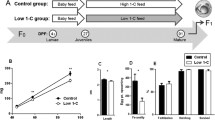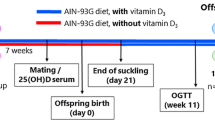Abstract
Purpose
1) To test the hypothesis of the existence of a perinatal vitamin A (VA) programming of VA metabolism and to better understand the intestinal regulation of VA metabolism.
Methods
Offspring from rats reared on a control (C) or a VA-deficient (D) diet from 6 weeks before mating until offspring weaning, i.e., 7 weeks after mating, were themselves reared on a C or D diet for 19 weeks, resulting in the following groups: C–C (parents fed C—offspring fed C), D-C, C-D and D-D. VA concentrations were measured in plasma and liver. β-Carotene bioavailability and its intestinal conversion rate to VA, as well as vitamin D and E bioavailability, were assessed after gavages with these vitamins. Expression of genes involved in VA metabolism and transport was measured in intestine and liver.
Results
C–D and D–D had no detectable retinyl esters in their liver. Retinolemia, hepatic retinol concentrations and postprandial plasma retinol response to β-carotene gavage were higher in D–C than in C–C. Intestinal expression of Isx was abolished in C–D and D–D and this was concomitant with a higher expression of Bco1, Scarb1, Cd36 and Lrat in males receiving a D diet as compared to those receiving a C diet. β-Carotene, vitamin D and E bio-availabilities were lower in offspring receiving a D diet as compared to those receiving a C diet.
Conclusion
A VA-deficient diet during the perinatal period modifies the metabolism of this vitamin in the offspring. Isx-mediated regulation of Bco1 and Scarb1 expression exists only in males severely deficient in this vitamin. Severe VA deficiency impairs β-carotene and vitamin D and E bioavailability.







Similar content being viewed by others
References
Wirth JP, Petry N, Tanumihardjo SA, Rogers LM, McLean E, Greig A, Garrett GS, Klemm RD, Rohner F (2017) Vitamin A supplementation programs and country-level evidence of vitamin a deficiency. Nutrients 9(3):190. https://doi.org/10.3390/nu9030190
Sahile Z, Yilma D, Tezera R, Bezu T, Haileselassie W, Seifu B, Ali JH (2020) Prevalence of vitamin A deficiency among preschool children in Ethiopia: a systematic review and meta-analysis. Biomed Res Int 2020:1–12. https://doi.org/10.1155/2020/8032894
Bruins M, Kraemer K (2013) Public health programmes for vitamin A deficiency control. Community Eye Health 26(84):69–70
Tang G, Qin J, Dolnikowski GG, Russell RM, Grusak MA (2009) Golden Rice is an effective source of vitamin A. Am J Clin Nutr 89(6):1776–1783
Amah D, van Biljon A, Brown A, Perkins-Veazie P, Swennen R, Labuschagne M (2019) Recent advances in banana (musa spp) biofortification to alleviate vitamin A deficiency. Crit Rev Food Sci Nutr 59(21):3498–3510. https://doi.org/10.1080/10408398.2018.1495175
Borel P, Hammaz F, Morand-Laffargue L, Creton B, Halimi C, Sabatier D, Desmarchelier C (2021) Using black soldier fly larvae reared on fruits and vegetables waste as a sustainable dietary source of provitamin a carotenoids. Food Chem 359:129911. https://doi.org/10.1016/j.foodchem.2021.129911
Underwood BA (2004) Vitamin A deficiency disorders: international efforts to control a preventable “pox.” J Nutr 134(1):231S-236S
Balmer JE, Blomhoff R (2002) Gene expression regulation by retinoic acid. J Lipid Res 43(11):1773–1808. https://doi.org/10.1194/jlr.r100015-jlr200
vanVliet T, vanVlissingen MF, vanSchaik F, vandenBerg H, (1996) beta-carotene absorption and cleavage in rats is affected by the vitamin A concentration of the diet. J Nutr 126(2):499–508
Boileau AC, Lee CM, Erdman JW (2000) Vitamin A deficiency reduces uptake of beta-carotene by brush border membrane vesicles but does not alter intestinal retinyl ester hydrolase activity in the rat. J Nutr Biochem 11(9):436–442. https://doi.org/10.1016/s0955-2863(00)00102-9
Lobo GP, Amengual J, Baus D, Shivdasani RA, Taylor D, von Lintig J (2013) Genetics and diet regulate vitamin A production via the homeobox transcription factor ISX. J Biol Chem 288:9017–9027
Lobo GP, Hessel S, Eichinger A, Noy N, Moise AR, Wyss A, Palczewski K, von Lintig J (2010) ISX is a retinoic acid-sensitive gatekeeper that controls intestinal beta, beta-carotene absorption and vitamin A production. FASEB J 24(6):1656–1666
Widjaja-Adhi MA, Lobo GP, Golczak M, Von Lintig J (2015) A genetic dissection of intestinal fat-soluble vitamin and carotenoid absorption. Hum Mol Genet 24(11):3206–3219. https://doi.org/10.1093/hmg/ddv072
Grolier P, Duszka C, Borel P, Alexandre-Gouabau MC, Azais-Braesco V (1997) In vitro and in vivo inhibition of beta-carotene dioxygenase activity by canthaxanthin in rat intestine. Arch Biochem Biophys 348(2):233–238
Duszka C, Grolier P, Azim EM, Alexandre-Gouabau MC, Borel P, Azais-Braesco V (1996) Rat intestinal beta-carotene dioxygenase activity is located primarily in the cytosol of mature jejunal enterocytes. J Nutr 126(10):2550–2556
Amengual J, Widjaja-Adhi MA, Rodriguez-Santiago S, Hessel S, Golczak M, Palczewski K, von Lintig J (2013) Two carotenoid oxygenases contribute to mammalian provitamin A metabolism. J Biol Chem 288(47):34081–34096. https://doi.org/10.1074/jbc.M113.501049
von Lintig J (2012) Provitamin A metabolism and functions in mammalian biology. Am J Clin Nutr 96(5):1234S-1244S. https://doi.org/10.3945/ajcn.112.034629
Lobo GP, Amengual J, Palczewski G, Babino D (1821) von Lintig J (2012) Mammalian carotenoid-oxygenases: key players for carotenoid function and homeostasis. Biochim Biophys Acta 1:78–87. https://doi.org/10.1016/j.bbalip.2011.04.010
van Bennekum A, Werder M, Thuahnai ST, Han CH, Duong P, Williams DL, Wettstein P, Schulthess G, Phillips MC, Hauser H (2005) Class B scavenger receptor-mediated intestinal absorption of dietary beta-carotene and cholesterol. Biochemistry (Mosc) 44(11):4517–4525
Borel P, Lietz G, Goncalves A, Szabo de Edelenyi F, Lecompte S, Curtis P, Goumidi L, Caslake MJ, Miles EA, Packard C, Calder PC, Mathers JC, Minihane AM, Tourniaire F, Kesse-Guyot E, Galan P, Hercberg S, Breidenassel C, Gonzalez Gross M, Moussa M, Meirhaeghe A, Reboul E (2013) CD36 and SR-BI Are Involved in Cellular Uptake of Provitamin A Carotenoids by Caco-2 and HEK Cells, and Some of Their Genetic Variants Are Associated with Plasma Concentrations of These Micronutrients in Humans. J Nutr 143:448–456
Seino Y, Miki T, Kiyonari H, Abe T, Fujimoto W, Kimura K, Takeuchi A, Takahashi Y, Oiso Y, Iwanaga T, Seino S (2008) Isx participates in the maintenance of vitamin A metabolism by regulation of beta-carotene 15,15’-monooxygenase (Bcmo1) expression. J Biol Chem 283(8):4905–4911
Lemke SL, Dueker SR, Follett JR, Lin Y, Carkeet C, Buchholz BA, Vogel JS, Clifford AJ (2003) Absorption and retinol equivalence of beta-carotene in humans is influenced by dietary vitamin A intake. J Lipid Res 44(8):1591–1600
Goswami BC, Ivanoff KD, Barua AB (2003) Absorption and conversion of 11,12-(3)H-beta-carotene to vitamin A in sprague-dawley rats of different vitamin A status. J Nutr 133(1):148–153
Borel P, Troadec R, Damiani M, Halimi C, Nowicki M, Guichard P, Margier M, Astier J, Grino M, Reboul E, Landrier JF (2021) β-Carotene bioavailability and conversion efficiency are significantly affected by the sex of rats First observation suggesting a possible hormetic regulation of vitamin A metabolism in female rats. Mol Nutr Food Res 65(22):e2100650. https://doi.org/10.1002/mnfr.202100650
Reboul E, Borel P (2011) Proteins involved in uptake, intracellular transport and basolateral secretion of fat-soluble vitamins and carotenoids by mammalian enterocytes. Prog Lipid Res 50:388–402
Bieri JG, Al Wu, Tolliver TJ (1981) Reduced intestinal absorption of vitamin E by low dietary levels of retinoic acid in rats. J Nutr 11:458–467
Sapin V, Alexandre MC, Chaib S, Bournazeau JA, Sauvant P, Borel P, Jacquetin B, Grolier P, Lemery D, Dastugue B, AzaisBraesco V (2000) Effect of vitamin A status at the end of term pregnancy on the saturation of retinol binding protein with retinol. Am J Clin Nutr 71(2):537–543
Hales CN, Barker DJ (2001) The thrifty phenotype hypothesis. Br Med Bull 60:5–20. https://doi.org/10.1093/bmb/60.1.5
Brenner S, Brooks MCH, Roberts LJ (1942) The relation of liver stores to the occurence of early signs of vitamin A deficiency in white rats. J Nutr 23:459–471
Hoffmann R, Schneider A, Quamo Y (1950) The sex difference in vitamin A metabolism. J Invest Dermatol 15(6):409–419. https://doi.org/10.1038/jid.1950.123
Roodenburg AJC, West CE, Hovenier R, Beynen AC (1995) Evaluation of a two-generation rat model for vitamin A deficiency and the interrelationship with iron metabolism. Br J Nutr 74:689–700
Boullu-Ciocca S, Achard V, Tassistro V, Dutour A, Grino M (2008) Postnatal programming of glucocorticoid metabolism in rats modulates high-fat diet-induced regulation of visceral adipose tissue glucocorticoid exposure and sensitivity and adiponectin and proinflammatory adipokines gene expression in adulthood. Diabetes 57(3):669–677. https://doi.org/10.2337/db07-1316
D’Ambrosio DN, Clugston RD, Blaner WS (2011) Vitamin A metabolism: an update. Nutrients 3(1):63–103
Borel P, Caillaud D, Cano NJ (2013) Vitamin D bioavailability: State of the art. Crit Rev Food Sci Nutr 55:1193–1205. https://doi.org/10.1080/10408398.2012.688897
Desmarchelier C, Borel P, Goncalves A, Kopec R, Nowicki M, Morange S, Lesavre N, Portugal H, Reboul E (2016) A Combination of Single-Nucleotide Polymorphisms Is Associated with Interindividual Variability in Cholecalciferol Bioavailability in Healthy Men. J Nutr 146(12):2421–2428. https://doi.org/10.3945/jn.116.237115
Ramkumar S, Moon J, Golczak M, von Lintig J (2021) LRAT coordinates the negative-feedback regulation of intestinal retinoid biosynthesis from beta-carotene. J Lipid Res 62:100055. https://doi.org/10.1016/j.jlr.2021.100055
Reboul E, Klein A, Bietrix F, Gleize B, Malezet-Desmoulins C, Schneider M, Margotat A, Lagrost L, Collet X, Borel P (2006) Scavenger receptor class B type I (SR-BI) is involved in vitamin E transport across the enterocyte. J Biol Chem 281(8):4739–4745
Reboul E, Goncalves A, Comera C, Bott R, Nowicki M, Landrier JF, Jourdheuil-Rahmani D, Dufour C, Collet X, Borel P (2011) Vitamin D intestinal absorption is not a simple passive diffusion: Evidences for involvement of cholesterol transporters. Mol Nutr Food Res 55:691–702
Tanumihardjo SA (2004) Assessing vitamin A status: past, present and future. J Nutr 134(1):290S-293S
Acknowledgements
The authors thank Benjamin Guillet for giving us access to the animal facility.
This project received funding from both the AlimH department of INRA (ANSSD 2016) and the G.L.N. (Groupe Lipides et Nutrition) in 2017.
Author information
Authors and Affiliations
Contributions
Patrick Borel: Conceptualization, Methodology, first interpretation of the results, Resources, Writing—Original Draft, Supervision, Project administration, Funding acquisition. Romane Troadec: HPLC analysis, gene expression, figures. Morgane Damiani: HPLC and gene expression analysis. Charlotte Halimi: HPLC analysis and preparation of β-carotene and vitamins D and E rich emulsions, tissue sampling. Marion Nowicki: gene expression, tissue sampling. Charlene Couturier: tissue sampling. Philippe Guichard: nutritional intervention on rats, rat gavages, blood sampling. Marielle Margier: tissue sampling. Lourdes Mounien: tissue sampling. Michel Grino: conceptualization, methodology, nutritional intervention on rats, rat gavages, blood sampling. Emmanuelle Reboul: conceptualization, tissue sampling, review and editing. Jean-François Landrier: conceptualization, gene expression validation, review and editing. Charles Desmarchelier: Statistics, interpretation of the results, Writing—Original Draft.
Corresponding author
Ethics declarations
Conflict of interest
None of the authors reported a potential conflict of interest.
Supplementary Information
Below is the link to the electronic supplementary material.
Rights and permissions
Springer Nature or its licensor holds exclusive rights to this article under a publishing agreement with the author(s) or other rightsholder(s); author self-archiving of the accepted manuscript version of this article is solely governed by the terms of such publishing agreement and applicable law.
About this article
Cite this article
Borel, P., Troadec, R., Damiani, M. et al. Vitamin A deficiency during the perinatal period induces changes in vitamin A metabolism in the offspring. The regulation of intestinal vitamin A metabolism via ISX occurs only in male rats severely vitamin A-deficient. Eur J Nutr 62, 633–646 (2023). https://doi.org/10.1007/s00394-022-03019-2
Received:
Accepted:
Published:
Issue Date:
DOI: https://doi.org/10.1007/s00394-022-03019-2




